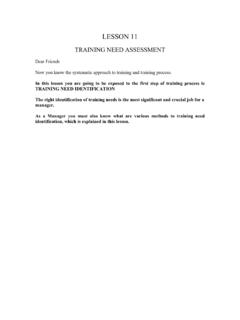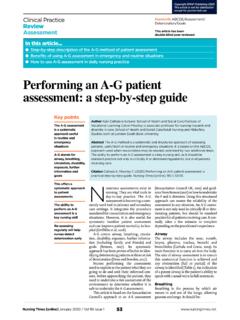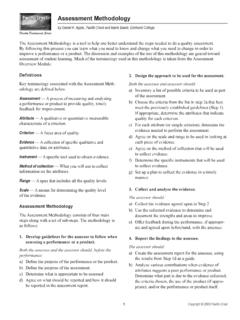Transcription of I. ASSESSMENT TOOLS
1 I. ASSESSMENT ASSESSMENT Tool: Food Security & Livelihoods in First Nutrition Programs: An ASSESSMENT Tool for How Agricultural Technologies Can Change GenderDynamics and Food Security Nutrition with Agricultural : A Tool for Assessing National Practices, Policies & Change Perspectives on Gender and Value KAP Survey Model (Knowledge, Attitudes, and Practices) Food Security & Vulnerability , Practice, & Coverage Survey (KPC) of the ASSESSMENT and Food Security ASSESSMENT in Emergencies Guidelines and for Industrial Value Chain Food Security Using Household Expenditure Food Security Market Mapping and Analysis Vulnerability Market Security & Livelihoods ASSESSMENT : A Practical Guide for Field Food Security ASSESSMENT ASSESSMENT for for Value Chain Needs Assessments: Water, Sanitation, and Economy Approach.
2 Practitioners Rural Appraisal and Participatory Rural Livelihood Security System Security to Conduct a Food Commodity Value Chain Evaluation of Access and Coverage(SQUEAC)/Simplified Lot Quality Assurance Sampling Evaluation ofAccess and Coverage (SLEAC) Evaluation Procedures1. 48-HOUR ASSESSMENT TOOL: FOOD SECURITY & LIVELIHOODS IN FIRST PHASE EMERGENCYP athway Component: food production; food prices; agricultural income; food expenditure; food access; diet Date of Design: 2012 Designer: Oxfam/ Emergency Capacity Building Project Search Category: agricultural production; food access; consumption; farm & non-farm income; household food & non-food expenditure; value chains & market systems Contact Institution: Philippa Young, URL: SUMMARY Brief Description: The purpose of this tool is to obtain a quick understanding of the emergency food security and livelihood situation within the first few days after a rapid-onset disaster.
3 This tool collects information on food security and livelihoods. The results of this initial ASSESSMENT are meant to inform the design of first-phase responses, in the first six to eight weeks after a disaster occurs. A more detailed ASSESSMENT led by food security and livelihood specialists is expected to take place at a later date. Uses: This tool aims to support response teams to gather an adequate picture of the food security and livelihoods situation in order to design rapid responses that can meet immediate needs and protect livelihoods in the context of practical constraints that usually follow a rapid-onset crisis. Tool Components: The toolkit contains six separate documents: and Guidance : Technical RationaleThe ASSESSMENT questionnaire is divided into four sections: & Household Focus Group and Traders Status after the Disaster Questions for Delivery Structures Questions for MoneyTransfer and Other Actors Response PlansOPERATIONS Number of Staff Required: The number of staff on the ASSESSMENT team is not specified; this will vary depending on available resources.
4 Note that it is recommended that external technical staff (not the ASSESSMENT team) conduct the analysis and draw the response recommendations from the results. Time: The ASSESSMENT should take place within a week after a rapid-onset disaster, ideally within the first 48 hours. The ASSESSMENT should be completed, including recommendations and report writing, within a few days (ideally 48 hours). Cost of ASSESSMENT : Not specified; this will vary according to context. Training: The 48-hour ASSESSMENT tool is designed to be accessible to all levels of staff with different skill sets and experience. It was developed for: 1) humanitarian staff with no or limited technical skills ( : humanitarian program managers) and/or; 2) food security and livelihoods technical staff with little experience of rapid-onset disasters in urban and rural contexts.
5 Geographic Targeting: This is a community-focused ASSESSMENT tool and should be used on a clearly defined, disaster-affected area. Type of Data Collection: A variety of qualitative and quantitative data, including typical household food security, livelihoods, market functioning, money transfer systems, and water and sanitation systems, will be collected. Degree of Technical Difficulty: This tool is intended for staff with limited technical experience. However, analysis and response recommendations should be supported by more experienced staff. Complements other Resources: This tool can be used in conjunction with processes such as the Multi-Cluster/Sector Initial Rapid ASSESSMENT (MIRA) to complement them with detailed food security and livelihoods information necessary for rapid response design.
6 This ASSESSMENT tool assumes that an Emergency Market Mapping and Analysis (EMMA) might still be necessary a couple of weeks after the disaster and that if a Household Economy Approach (HEA) baseline exists, it can provide important background information on the pre-disaster context and outcome analysis and triangulate the findings of the 48-hour ASSESSMENT . CONTENT SUMMARY Brief Description: This toolkit describes an analytical process to understand the potential gender-related and nutritional impacts of specific agricultural technologies on men and women. The methodology aids practitioners and researchers in assessing whether the agricultural technologies they use or will use are gender-responsive and nutrition-sensitive in terms of design, use, and dissemination.
7 The toolkit consists of a guide in three parts: Learn, Apply, and Share. It offers readers an understanding of the relationships between gender, nutrition, and agricultural technologies and how to address these issues : The INGENAES technology ASSESSMENT can be used to improve the design and dissemination of agricultural technologies in ways that increase adoption by men and women farmers. Part 1: Learn. This section of the toolkit discusses the relationships between gender, nutrition, and agricultural technologies. It is divided into short thematic chapters that each describe one of three areas of inquiry: time and labor; food availability, access, safely, and quality; and income and assets.
8 Part 2: Apply. This section of the toolkit introduces a gender analysis framework and a range of TOOLS (questionnaires, worksheets) that can be used to Part 3: Share. This section of the toolkit is a facilitator s guide for designing and conducting a workshop on the methodology. The facilitator s guide is made up of slides and exercises that over the course of the pilot s four workshops were found to be most useful in sharing the Components:OPERATIONS Number of Staff Required: The number of staff needed to collect the qualitative data will be dependent on project needs and : The ASSESSMENT is designed to be applied after technologies have been introduced to farmers.
9 However, the questionnaires can be modified for use at different points in the technology development process. Early in the process, actors can use the ASSESSMENT to gather valuable information about men s and women s preferences and needs that can influence the selection of time-consuming and labor intensive tasks to upgrade or the design of other technologies. Later in the technology development process, the ASSESSMENT can inform dissemination strategies to ensure that products are accessible and affordable for men and women farmers. Cost of ASSESSMENT : Not specified; this will vary according to : The TOOLS were developed for readers with a basic understanding of gender and nutrition issues.
10 Part 1 of the toolkit serves as a training tool for implementers of the technology ASSESSMENT . Geographic Targeting: This is a community-focused ASSESSMENT tool. The primary data collection should be tailored to whatever size community received/is undergoing a technology of Data Collection: Quantitative and Qualitative (primary sources are surveys, key informant and group interviews; desktop research and a review of secondary literature about the technology should supplement primary data collection where available).Degree of Technical Difficulty: This toolkit is aimed towards agricultural researchers or practitioners interested in learning how to address gender and nutrition issues in their work.








